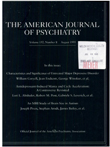Patterns of psychiatric comorbidity, cognition, and psychosocial functioning in adults with attention deficit hyperactivity disorder
Abstract
OBJECTIVE: Although attention deficit hyperactivity disorder is a common disorder of childhood, its status as a disorder in adults is not clear. The authors reasoned that if the adult diagnosis of the disorder is a valid clinical entity, it should be similar to the childhood disorder with regard to patterns of psychiatric and cognitive findings. METHODS: Eighty-four adults with a clinical diagnosis of childhood- onset attention deficit hyperactivity disorder confirmed by structured interview who were referred for treatment were studied. Findings were compared with those from a preexisting study group of referred children with attention deficit hyperactivity disorder, nonreferred adult relatives of those children who also had attention deficit hyperactivity disorder, and adults without the disorder who were relatives of normal children. Subjects were evaluated with a comprehensive battery of psychiatric, cognitive, and psychosocial assessments. RESULTS: The referred and nonreferred adults with attention deficit hyperactivity disorder were similar to one another but more disturbed and impaired than the comparison subjects without the disorder. The pattern of psychopathology, cognition, and functioning among the adults with attention deficit hyperactivity disorder approximated the findings for children with the disorder. CONCLUSIONS: These results show that referred and nonreferred adults with attention deficit hyperactivity disorder have a pattern of demographic, psychosocial, psychiatric, and cognitive features that mirrors well-documented findings among children with the disorder. These findings further support the validity of the diagnosis for adults.
Access content
To read the fulltext, please use one of the options below to sign in or purchase access.- Personal login
- Institutional Login
- Sign in via OpenAthens
- Register for access
-
Please login/register if you wish to pair your device and check access availability.
Not a subscriber?
PsychiatryOnline subscription options offer access to the DSM-5 library, books, journals, CME, and patient resources. This all-in-one virtual library provides psychiatrists and mental health professionals with key resources for diagnosis, treatment, research, and professional development.
Need more help? PsychiatryOnline Customer Service may be reached by emailing [email protected] or by calling 800-368-5777 (in the U.S.) or 703-907-7322 (outside the U.S.).



